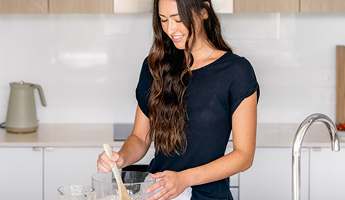Do you need to go every day? Should I use a squatty potty? What’s pooing got to do with bladder leaks? Bowel function plays a major role in maintaining a healthy bladder and preventing bladder leaks. Here’s what you need to know. .
What do you need to know about bowel function?
The bowel is the lower part of the digestive system, running from your stomach to your anus. It is a tube-like organ consisting of the small bowel and large bowel (or small and large intestines). Food passes along the bowel and fluids and nutrients are absorbed into your body or expelled as waste through the anus. We call the waste faeces, stool, or poo. .
Liquid is what enters your bowel, and as it moves towards the anus more and more fluid is absorbed back into the body, leaving a more solid waste product. The very last part of the bowel, before the anus, is called the rectum. This is where waste is stored until you are ready to do a poo. Your pelvic floor muscles and anal sphincters stop waste from coming out until you are sitting on the toilet. Doing a poo is a combination of automatic reflexes, and conscious relaxation of the pelvic floor muscles. Small movements in your bowel and reflexive relaxation of the internal sphincter are more likely to occur within 30 minutes of rising in the morning, and within 30 minutes of eating a meal. This is why you might feel the urge to do a poo at these times more than others. .
How often should you poo?
There is no set “ideal” for the frequency of opening your bowels. It can be normal to poo multiple times a day or a few times a week. More important than frequency is the texture of your poo. It should be soft, sausage shaped and easy to pass. Hard poo’s with cracks, poo’s that look like pellets or a poo that takes longer than 5 minutes to empty can be signs of constipation, regardless of how often you are going. .
Why is pooing so important if you have bladder leakage?
.The bladder and bowel are very close in proximity within the pelvis. Bowel conditions, especially constipation, can significantly worsen symptoms of urinary leakage. Large amounts of hard stool in the bowel and rectum can put pressure on the bladder, worsening stress and urge incontinence. Chronic straining on the toilet in the case of constipation can impact the functioning of the pelvic floor, and as a result also worsen symptoms of both stress and urge incontinence. .
A well-functioning bowel will:
- Empty somewhere between 3 times a day and once every 3 days.
- Be able to hold on for a short time after your first urge to poo.
- Not leak poo or wind if you aren’t ready.
- Pass a stool within approximately 5 minutes of sitting on the toilet.
- Pass a stool without overtly straining or pain.
- Give a sensation of completely empty after a poo.
Top tips for maintaining a healthy bowel
Drink water:
The right amount of water for you will be impacted by your size, level of activity, breastfeeding status, and any medications you take. If you are experiencing hard stools and know you don’t drink much water throughout the day, then try increasing your fluid intake.Go with your first urge:
Utilise your bowels automatic functions. Like we mentioned above this is likely to be first thing in the morning or shortly after eating a meal. Don’t repeatedly defer the urge to poo.Eat soluble and non-soluble fibre:
Soluble fibre dissolves in water whereas insoluble fibre does not. Both types play a role in healthy digestion. You can find these types of fibre in foods such as beans, bran, lentils, pears, prunes, figs, dates, spinach, pumpkin, apple, banana, psyllium husk or whole wheat bread/ pasta.Take a supplement if you are constipated:
This should be guided by a health professional, but we’ve written it here to stress the importance of treating constipation. If you’ve increased your dietary fibre and fluid intake and are still constipated, then get a product recommendation that’s right for you. Some supplements on the market targeted at treating constipation can actually make you more backed up!Relax your pelvic floor:
Don’t repeatedly strain to pass a bowel motion. Your pelvic floor muscles need to relax in order for your bowel to empty completely. You can aid this process by getting into a position with your knees up, feet flat and you are leaning forwards. A stool under your feet can greatly help here. If you can’t empty your bowels within 5 minutes, walk away and come back again another time when you get the urge.Understand your pelvic floor:
Know how to squeeze and relax your pelvic floor and practice pelvic floor exercises. You can find out more here in our 12 weeks to stronger pelvic floor program.See a doctor if you have sudden changes in bowel motions:
Your bowel can be an indicator of underlying health conditions or the presence of disease. If your poo is very dark/black or very light/ grey, and this is different from your normal poo, you should tell your doctor. Likewise, if you are seeing blood in your stool.
This content is general in nature and not designed to substitute professional medical advice, diagnosis, or treatment. .
Written for Poise by Caitlin Dunsford. Caitlin is a practicing Physiotherapist, with special interest and further training in Women's Health and Continence.







